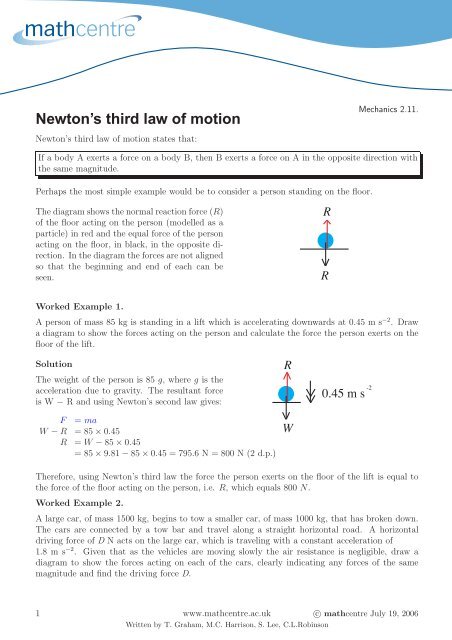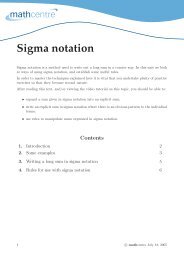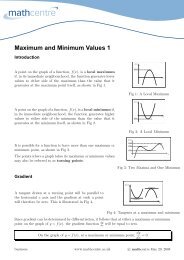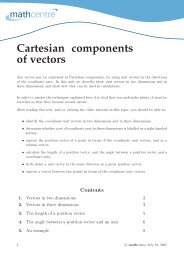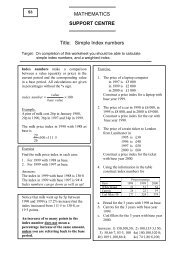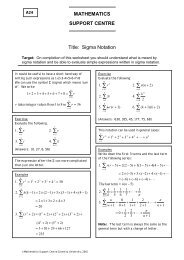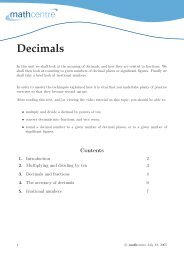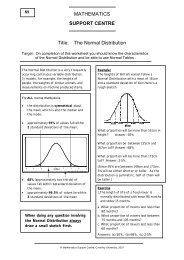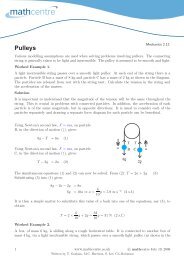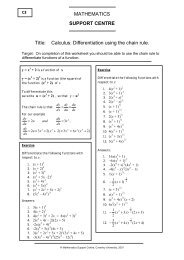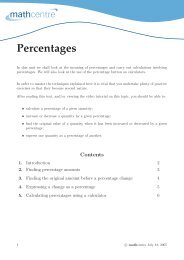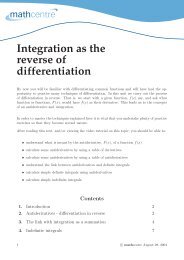Newton's third law of motion
Newton's third law of motion
Newton's third law of motion
You also want an ePaper? Increase the reach of your titles
YUMPU automatically turns print PDFs into web optimized ePapers that Google loves.
Newton’s <strong>third</strong> <strong>law</strong> <strong>of</strong> <strong>motion</strong><br />
Newton’s <strong>third</strong> <strong>law</strong> <strong>of</strong> <strong>motion</strong> states that:<br />
Mechanics 2.11.<br />
If a body A exerts a force on a body B, then B exerts a force on A in the opposite direction with<br />
the same magnitude.<br />
Perhaps the most simple example would be to consider a person standing on the floor.<br />
The diagram shows the normal reaction force (R)<br />
<strong>of</strong> the floor acting on the person (modelled as a<br />
particle) in red and the equal force <strong>of</strong> the person<br />
acting on the floor, in black, in the opposite direction.<br />
In the diagram the forces are not aligned<br />
so that the beginning and end <strong>of</strong> each can be<br />
seen.<br />
R<br />
R<br />
Worked Example 1.<br />
A person <strong>of</strong> mass 85 kg is standing in a lift which is accelerating downwards at 0.45 m s −2 . Draw<br />
a diagram to show the forces acting on the person and calculate the force the person exerts on the<br />
floor <strong>of</strong> the lift.<br />
Solution<br />
The weight <strong>of</strong> the person is 85 g, where g is the<br />
acceleration due to gravity. The resultant force<br />
is W − R and using Newton’s second <strong>law</strong> gives:<br />
F = ma<br />
W − R = 85 × 0.45<br />
R = W − 85 × 0.45<br />
= 85 × 9.81 − 85 × 0.45 = 795.6 N = 800 N (2 d.p.)<br />
R<br />
W<br />
0.45 m s -2<br />
Therefore, using Newton’s <strong>third</strong> <strong>law</strong> the force the person exerts on the floor <strong>of</strong> the lift is equal to<br />
the force <strong>of</strong> the floor acting on the person, i.e. R, which equals 800 N.<br />
Worked Example 2.<br />
A large car, <strong>of</strong> mass 1500 kg, begins to tow a smaller car, <strong>of</strong> mass 1000 kg, that has broken down.<br />
The cars are connected by a tow bar and travel along a straight horizontal road. A horizontal<br />
driving force <strong>of</strong> D N acts on the large car, which is traveling with a constant acceleration <strong>of</strong><br />
1.8 m s −2 . Given that as the vehicles are moving slowly the air resistance is negligible, draw a<br />
diagram to show the forces acting on each <strong>of</strong> the cars, clearly indicating any forces <strong>of</strong> the same<br />
magnitude and find the driving force D.<br />
1 www.mathcentre.ac.uk c○ mathcentre July 19, 2006<br />
Written by T. Graham, M.C. Harrison, S. Lee, C.L.Robinson
Solution<br />
As can be seen in the diagram, Newton’s <strong>third</strong><br />
<strong>law</strong> applies in the tow bar, with respect to the<br />
tension T. It also applies between the ground and<br />
each car.<br />
R1<br />
T<br />
T<br />
R2<br />
1.8 m s -2<br />
D<br />
F = ma<br />
D = 2500 × 1.8<br />
D = 4500 N<br />
(2 d.p.)<br />
1000g<br />
1500g<br />
Exercises<br />
1. A person <strong>of</strong> mass 94 kg is standing in a lift which is accelerating upwards at 0.54 m s −2 . Draw<br />
a diagram to show the forces acting on the person and calculate the force, F, the person exerts<br />
on the floor <strong>of</strong> the lift.<br />
2. A person <strong>of</strong> mass 65 kg is standing in a lift <strong>of</strong> mass 400 kg, which is accelerating upwards at<br />
0.6 m s −2 . Draw a diagram to show the forces acting on the lift and calculate their respective<br />
values.<br />
3. An engine, <strong>of</strong> mass 3500 kg, tows two carriages, each <strong>of</strong> mass 600 kg on a set <strong>of</strong> straight<br />
horizontal rails. Given that the engine has a horizontal driving force <strong>of</strong> D N and that as they<br />
are moving slowly the air resistance is negligible, draw a diagram to show the forces acting<br />
on the engine and both carriages, clearly indicating any forces <strong>of</strong> the same magnitude.<br />
4. A tug boat, <strong>of</strong> mass 8000 kg, is towing a smaller boat, <strong>of</strong> mass 2000 kg. Given that the tug<br />
boat has a horizontal driving force <strong>of</strong> D N and that they are accelerating at 1.2 m s −2 , draw<br />
a diagram to show the forces acting on both boats and calculate the driving force<br />
Answers (All to 2 s.f.)<br />
1.<br />
R = 970 N = F<br />
2.<br />
T = 4800 N<br />
0.54 m s -2<br />
0.6 m s -2<br />
W = 920 N<br />
W = 3900 N<br />
R = 680 N<br />
3.<br />
R1<br />
T1<br />
T1<br />
R1<br />
T2<br />
T2<br />
R2<br />
D<br />
4.<br />
F1<br />
T<br />
T<br />
F2<br />
1.2 m s -2<br />
D = 12000 N<br />
600g<br />
600g<br />
3500g<br />
2000g<br />
8000g<br />
2 www.mathcentre.ac.uk c○ mathcentre July 19, 2006<br />
Written by T. Graham, M.C. Harrison, S. Lee, C.L.Robinson


